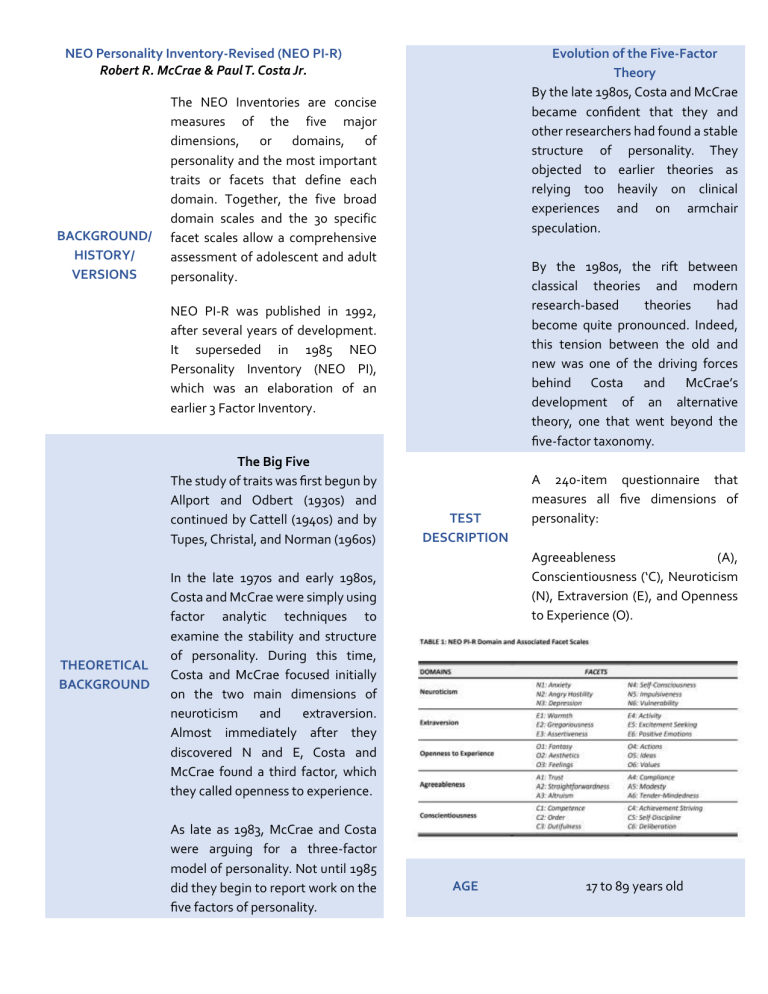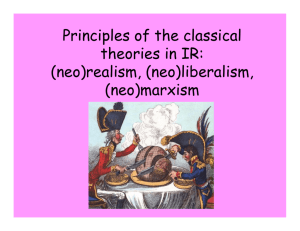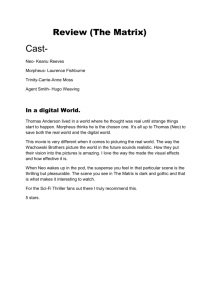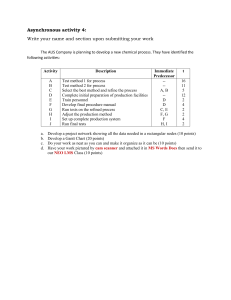
NEO Personality Inventory-Revised (NEO PI-R) Robert R. McCrae & Paul T. Costa Jr. BACKGROUND/ HISTORY/ VERSIONS THEORETICAL BACKGROUND Evolution of the Five-Factor Theory By the late 1980s, Costa and McCrae became confident that they and other researchers had found a stable structure of personality. They objected to earlier theories as relying too heavily on clinical experiences and on armchair speculation. The NEO Inventories are concise measures of the five major dimensions, or domains, of personality and the most important traits or facets that define each domain. Together, the five broad domain scales and the 30 specific facet scales allow a comprehensive assessment of adolescent and adult personality. NEO PI-R was published in 1992, after several years of development. It superseded in 1985 NEO Personality Inventory (NEO PI), which was an elaboration of an earlier 3 Factor Inventory. By the 1980s, the rift between classical theories and modern research-based theories had become quite pronounced. Indeed, this tension between the old and new was one of the driving forces behind Costa and McCrae’s development of an alternative theory, one that went beyond the five-factor taxonomy. The Big Five The study of traits was first begun by Allport and Odbert (1930s) and continued by Cattell (1940s) and by Tupes, Christal, and Norman (1960s) A 240-item questionnaire that measures all five dimensions of personality: TEST DESCRIPTION Agreeableness (A), Conscientiousness (‘C), Neuroticism (N), Extraversion (E), and Openness to Experience (O). In the late 1970s and early 1980s, Costa and McCrae were simply using factor analytic techniques to examine the stability and structure of personality. During this time, Costa and McCrae focused initially on the two main dimensions of neuroticism and extraversion. Almost immediately after they discovered N and E, Costa and McCrae found a third factor, which they called openness to experience. As late as 1983, McCrae and Costa were arguing for a three-factor model of personality. Not until 1985 did they begin to report work on the five factors of personality. AGE 17 to 89 years old $85 per single administration + short report (graphic description). supplement to self-reports from adult clients. $110 per single administration + long version report (graphic description and interpretation report) Each item is rated on a 5-point Likert scale. Internal consistency coefficients for both Forms R and S range from .86-.95 for domain scales and from .56-.90 for facet scales. The NEO PI-R is validated against other personality inventories as well as projective techniques. PRICE PER TEST ADMINISTRATION May be administered individually or by groups. Environment must be comfortable and free from distractions and provide adequate lighting. A pencil and a flat surface such as a desk and a clipboard on which the respondents can write are also needed for administration. If the respondents use eyeglasses, the examiner should be sure that the respondents use them during testing. The examiner should engage the respondents in the task of completing the test to reduce the possibility of response sets or random responding to the items. TIME QUALIFICATION LEVEL The NEO PI-R is self-administered and is available in two parallel versions. each version contains 240 items, and 3 validity items and requires a 6th grade reading level. Form S, designed for self-reports, is appropriate for use with adult men and women, including individuals of college age. Form R, designed for observer reports, is written in the third person for peer, spouse, or expert ratings. Use as an alternative measure or as a SCORING 30-40 minutes/35-45 minutes Level B/S The administration and scoring of their instruments can be performed by individuals who do not have formal training in clinical psychology, personality, or related fields. Interpretation of NEO PI-R requires professional training in psychological testing and measurement, in addition to familiarity with the materials and procedures presented in this Professional Manual. NEO PI-R should not be scored if 41 or more responses are missing. If fewer than 41 responses are missing, the missing items should be scored as if the neutral response option was selected. INTERPRETATION RELIABILITY Internal consistency coefficients were calculated at 0.86 to 0.95 for both the forms (self and observer). While only three of the subtests had good long-term testretest reliability (Neuroticism, Extraversion, Openness to Experience), all of them had high short-term test-retest reliability. Internal consistency coefficients were calculated at 0.86 to 0.95 for both the forms (self and observer). While only three of the subtests had good long-term testretest reliability (Neuroticism, Extraversion, Openness to Experience), all of them had high short-term test-retest reliability. The authors of the NEO PI-R maintain that empirical evidence does not support the use of validity scales. Instead, three simple items were included at the conclusion of the inventory asking examinees if they had tried to respond to items in an honest and accurate manner, if they had answered all items, and if responses had been entered in the correct space. VALIDITY In response to criticism of the lack of formal validity scales, three NEO PIR research validity scales were developed by Schinka, Kinder, and Kremer (1997): Inconsistent Responding scale – to assess random responding. Negative Presentation Management scale - to assess negative response distortion/overreporting or “faking bad” Positive Presentation Management (PPM) scale - to assess positive response distortion/underreporting or “faking good.” The NEO PI-R items are non-invasive and possess face-validity, but like most objective inventories the items are also transparent and thus vulnerable to positive response bias. UTILITY The utility of the NEO PI-R is clearly related to the professional’s background and knowledge. Corporate setting (job profiling) The utility of the NEO PI-R is clearly related to the professional’s background and knowledge. Corporate setting (job profiling) REFERENCES: Costa, P. (1992, January). Neo PI-R professional manual. ResearchGate. https://www.researchgate.net/publication/240133762_Neo_P I-R_professional_manual Detrick, P. (n.d.). NEO Personality Inventory-Revised (NEO PIR). https://post.ca.gov/portals/0/post_docs/publications/psychol ogical-screening-manual/NEO_PI-R.pdf Feist, J., Feist, G. J. D., & Roberts, T. (2017). Theories of Personality (9th ed.). McGraw-Hill Education Neo personality inventory-revised (Neo Pi-R). Statistics Solutions. (2023, May 22). https://www.statisticssolutions.com/freeresources/directory-of-survey-instruments/neo-personalityinventory-revised-neo-pir/#:~:text=Reliability%20and%20Validity&text=While%20onl y%20three%20of%20the,%2C%20convergent%2C%20and% 20divergent%20validity.




